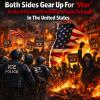
Breaking News
 BREAKING EXCLUSIVE: Kyle Rittenhouse Warns The Left Is Preparing To Stage A False Flag To Blame...
BREAKING EXCLUSIVE: Kyle Rittenhouse Warns The Left Is Preparing To Stage A False Flag To Blame...
 The Biggest Grid We Escaped (It Wasn't Power)
The Biggest Grid We Escaped (It Wasn't Power)
 Both Sides Gear Up For "War" As An Internal Revolution Begins To Erupt In The United State
Both Sides Gear Up For "War" As An Internal Revolution Begins To Erupt In The United State
 The Good News Is People Are Realizing We're On Our Own
The Good News Is People Are Realizing We're On Our Own
Top Tech News
 World's most powerful hypergravity machine is 1,900X stronger than Earth
World's most powerful hypergravity machine is 1,900X stronger than Earth
 New battery idea gets lots of power out of unusual sulfur chemistry
New battery idea gets lots of power out of unusual sulfur chemistry
 Anti-Aging Drug Regrows Knee Cartilage in Major Breakthrough That Could End Knee Replacements
Anti-Aging Drug Regrows Knee Cartilage in Major Breakthrough That Could End Knee Replacements
 Scientists say recent advances in Quantum Entanglement...
Scientists say recent advances in Quantum Entanglement...
 Solid-State Batteries Are In 'Trailblazer' Mode. What's Holding Them Up?
Solid-State Batteries Are In 'Trailblazer' Mode. What's Holding Them Up?
 US Farmers Began Using Chemical Fertilizer After WW2. Comfrey Is a Natural Super Fertilizer
US Farmers Began Using Chemical Fertilizer After WW2. Comfrey Is a Natural Super Fertilizer
 Kawasaki's four-legged robot-horse vehicle is going into production
Kawasaki's four-legged robot-horse vehicle is going into production
 The First Production All-Solid-State Battery Is Here, And It Promises 5-Minute Charging
The First Production All-Solid-State Battery Is Here, And It Promises 5-Minute Charging
 See inside the tech-topia cities billionaires are betting big on developing...
See inside the tech-topia cities billionaires are betting big on developing...
How to Get Wi-Fi Without an Internet Service Provider: 5 Ways

Getting on the web is expensive. In the United States, the average cost of a home internet connection is $60 per month. Don't fancy paying all that money? Don't worry; even if you don't have a regular ISP, there are still ways to go online.
Here are some ways to get Wi-Fi without an Internet Service Provider.
1. Mobile Hotspot
The best way to make sure you have the internet on your laptop at all times is to use a mobile hotspot.
Of course, there is an upfront cost of doing so—you will need to buy a hotspot device and subscribe to a mobile internet plan. Quite a few companies offer mobile hotspots.
There are three mobile hotspot models we particularly recommend:
Despite being a couple of years old, the Verizon Jetpack MiFi 8800L is probably still the best 4G hotspot available right now. It uses Qualcomm's X20 modem and supports 11 LTE bands. It provides both 2.4 and 5GHz mobile networks, supports guest connections, and allows you to connect up to 15 devices to the network at once.
The device is only available through Verizon. You can get the device for $99 if you sign up for a two-year mobile internet contract. It is $199 if you buy the device contract-free.

 Storage doesn't get much cheaper than this
Storage doesn't get much cheaper than this

